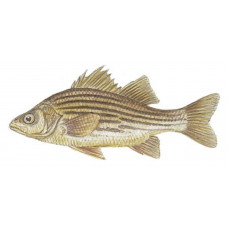Latin name
Morone mississippiensis
Other names
Barfish, brassy bass, stripe, striped bass, streaker, yellowjack, jack, streaks, gold bass.
Identification
The body shape of the yellow bass is very similar to that of the white bass: moderately long and stocky, with the deepest part between the dorsal fins, as, opposed to round and compressed. It has a small head, large mouth, and connected dorsal fins. The coloration is copper-silver or bright yellow, sometimes with a grayish-olive tint on the back, and the fins are clear to bluish-gray, especially blue when the fish is in the water. Five to eight distinct dark horizontal stripes run along the sides, and the lower stripes may be irregularly interrupted and shifted over the anal fin. These markings are different on both sides of the fish. Yellow bass can be distinguished from white bass by its golden coloration and intermittent stripes. It also has a second anal fin spine that is longer and thicker than the third. In white bass, it is noticeably shorter. The jaws of the yellow bass are straight, while the lower jaw of the white bass protrudes forward.
Distribution
Yellow bass inhabit the Lake Michigan and Mississippi basins from Minnesota, Wisconsin, and Michigan south to the Pearl River drainage in Louisiana, the Galveston Bay drainage in Texas, the lower Coos and Mobile Bay drainage, east to western Indiana and eastern Tennessee, and west to western Iowa and eastern Oklahoma. Found mostly in the central Mississippi Valley, they have been stocked only within their native range and transplanted to neighboring states and have generally not been successful elsewhere. They are scattered within this range and vary in numbers from lake to lake.
Habitat
Yellow bass thrives in quiet pools, ponds, backwaters of large streams, small and large rivers, large lakes, clear and murky waters below lakes and reservoirs. It is tolerant of overgrown weeds, more so than white bass, and likes warm water.
Size
Yellow bass are smaller than the largest bluegills, and the usual size caught by anglers ranges from 4 to 12 ounces. They can grow up to 2 pounds and 18 inches, although specimens weighing more than a pound are rare. The world record among all tackle is held by an Indiana fish weighing 2 pounds, 4 ounces, caught in 1977. Once grown, these fish grow slowly and rarely reach the size of white bass, perhaps because they are extremely prolific and often stunted. Their lifespan is short, averaging about 4 years, they can live up to 7 years.
Life history and Behavior
Yellow bass spawn in the spring and move into tributary streams when water temperatures reach the upper 50 degrees. They spawn in shoals and leave their nesting sites without protecting their young.
Food and feeding habits
Yellow bass feed on insects, minnows, small shad, and small sunfish. Insects and insect larvae make up, a significant part of their diet, especially the smaller sizes. The fish are more active in shallow and nearshore waters in the early and late afternoon, and move to deeper expanses of open water during the day.
Reproduction
No information
| Classification | |
| Phylum | Chordata |
| Class | Actinopterygii |
| Squad | Perciformes |
| Family | Moronidae |
| Genus | Morone |
| Species | M. mississippiensis |
| Features | |
| Conservation status | Secure |
| Habitat | Pelagic |
| Life span, years | 7 |
| Maximum body weight, kg | 1 |
| Maximum length, cm | No information |
| Sailing speed, m/s | No information |
| Threat to people | Edible |
| Way of eating | Predator |

